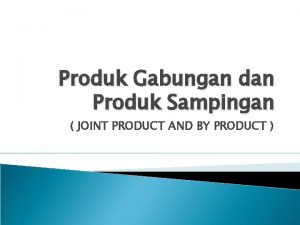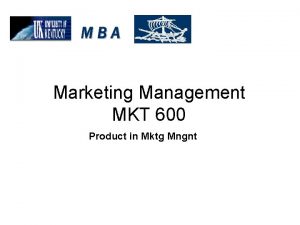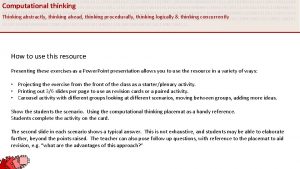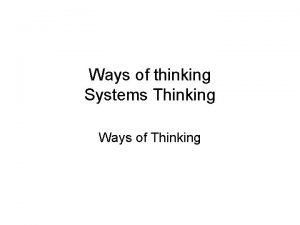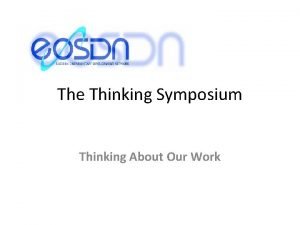Product Life Thinking Product Life Thinking Product Life














- Slides: 14

Product Life Thinking

Product Life Thinking

Product Life Thinking

Product Life Thinking Step 1: Use Context. . • What should the product be used for? • What does the product do? - For whom? - How long? - How often? - Where in the world? “What does the product do? ” allows for a description of the product’s functionality, including the technological principles and the features that the product must possess in order to deliver the service to the user. Sub-functions may, for example, be ”to stick to the skin” All in all, these responses lead to a clear description of the product in the form of the value contribution that the product delivers to the user.

Product Life Thinking

Product Life Thinking

Product Life Thinking Step 2: Create an overview of environmental impact Draw five boxes that correspond to the main product life stages on a large piece of paper. Carry out a brainstorming exercise in which everyone in the group writes all relevant environmental impacts that they can think of. Use post-it notes, as these will be moved around a little later. Write only one environmental impact per post-it note! Organise these environmental impacts in relation to the five product life stages. Write everything you think of, regardless of whether you know that an environmental impact is relevant for the product, or whether you just have an idea about its relevance. The exercise is complete, when the group cannot produce any more ideas. Tidy up the poster by removing any duplicates.

Product Life Thinking Step 2: Create an overview of environmental impact When you look at the product life résumé, patterns can be identified. Maybe one particular product life stage is dominant, as it clearly contains the vast majority of the environmental impacts? On the other hand, some product life résumés may represent a more or less even distribution of environmental aspects, across all life cycle stages. Maybe a particular part of the product (e. g. , “the battery”) appears many times, and thus appears to be worth focusing on. Since the product life résumé shows the environmental aspects distributed over product life stages, it is easy to quickly identify environmental focus areas.

Product Life Thinking Step 2: Create an overview of environmental impact Which phase has most impact?

Product Life Thinking Step 2: Create an overview of environmental impact Which phase has most impact?

Product Life Thinking Step 2: Create an overview of environmental impact

Product Life Thinking Step 2: Create an overview of environmental impact

Product Life Thinking Step 3: Create a MECO matrix

Product Life Thinking Step 3: Create a MECO matrix Draw a MECO-matrix directly under the product life résumé from Step 2. The MECO-matrix should be a 4 x 5 matrix with space for the post-it notes, which are currently distributed on the product life résumé. In dialogue with your group, move the post-it notes from the product life résumé, down to the MECOmatrix. Consider each environ- mental impact in turn, placing them in the most relevant MECO-field. If an environmental impact covers two or more MECO-fields, copy the post-it note and then place one in each relevant field. The first part of this exercise is complete when all post-it notes have been moved down to MECO-matrix. Discuss the MECO-matrix in your group and gather certain environmental impacts together, if strong relationships are apparent, within each MECO-field. Identify the most important environmental focus areas (choose your top 5) by drawing a ’*’ on the relevant post-it notes. This part of the exercise is complete when the group has agreed on a prioritisation.
 Positive thinking vs negative thinking examples
Positive thinking vs negative thinking examples Thinking about your own thinking
Thinking about your own thinking Analytic vs holistic thinking example
Analytic vs holistic thinking example Perbedaan critical thinking dan creative thinking
Perbedaan critical thinking dan creative thinking Thinking about you thinking about me
Thinking about you thinking about me Product life cycle kotler
Product life cycle kotler Critical thinking in everyday life
Critical thinking in everyday life What's next thinking about life after high school
What's next thinking about life after high school When it comes to thinking about life after high school
When it comes to thinking about life after high school Apa itu joint product
Apa itu joint product Relationship between total average and marginal product
Relationship between total average and marginal product Product mix vs product line
Product mix vs product line Core product actual product
Core product actual product Inner product outer product
Inner product outer product Management prowess example
Management prowess example









